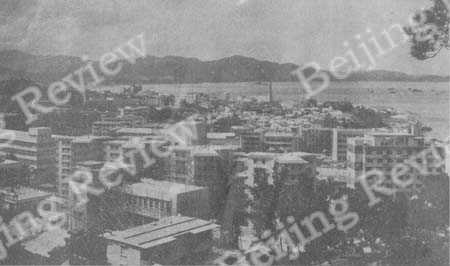
Zhuhai, formerly a small town on the coast of the South China Sea, is now a large special economic zone.
In 1980, China began building special economic zones in Shenzhen, Zhuhai and Shantou in Guangdong Province and in Xiamen in Fujian Province. Shenzhen, adjacent to Xianggang (Hongkong), is the largest, covering an area of 327.5 square kilometres, and its construction is advancing quickly.
Shenzhen: Opening to the World
Special economic zones are an important part of China's policy of opening to the world. The idea was first put forward at the end of 1978, when China began its modernization drive. The National People's Congress formally approved the special zones in Guangdong Province in August 1980 and the Xiamen zone two months later.
Modern methods of mass production and the formation of international markets have led to production and consumption on a world scale. To offset their weaknesses, developed and developing countries are bound to learn from each other's strong points through extensive economic co-operation and technical exchanges. One form of international co-operation is the special economic zone. More than 70 countries and regions in various parts of the world have established processing-exporting or free-trade zones, where forms of preferential treatment are allowed in order to attract foreign investors. These investors build factories, which in turn import advanced technology, create jobs, bring in foreign exchange and promote general economic development.
As a developing socialist country, China relies mainly on its own forces to bring about modernization. Of course, it will try to win foreign assistance, actively develop economic co-operation, and reasonably use and absorb all foreign things useful to it. For these reasons, China has gone ahead with its decisive policy to set up special economic zones.
Shenzhen's geography and other conditions favour its position as a special economic zone. It has bounteous natural resources and wide political, economical and cultural connections with Xianggang (Hongkong) and Aomen (Macao). It is also one of China's major ports and has access to major roads, railways and airports. With the large-scale exploration of oil in the nearby South China Sea and the planned construction of a nuclear power station in neighbouring Dayawan, Shenzhen is certain to prosper.
There are many advantages to setting up special economic zones. (1) Through preferential policies these zones can use large amounts of foreign investment in a better way, import advanced technology, and acquire scientific techniques and management skills - all of which will enable the country as a whole to develop economically at a quicker pace. (2) By dealing regularly with foreign capital, we can further observe and understand the development of and changes in the modern capitalist world, and keep abreast of the changes on the international markets and in science and technology. (3) Through co-operation, we can learn modern urban construction and management methods, and train professionals.
Policy Decisions
The managerial systems, policies and measures in the special economic zones are quite different from those in the rest of China. These are some of them.
- Enterprises run exclusively by foreign or overseas Chinese capital have the right to manage themselves, provided they observe Chinese laws and regulations.
- Joint ventures and co-operative enterprises are managed by their own boards of directors. In general, the governments of the special zones do not interfere in the administration of the enterprises.
- Enterprises operate under the labour-contract system, according to which they can recruit qualified workers through exams. Both enterprise and worker sign a contract.
- Enterprises are allowed to pay floating wages and salaries or to pay by the piece.
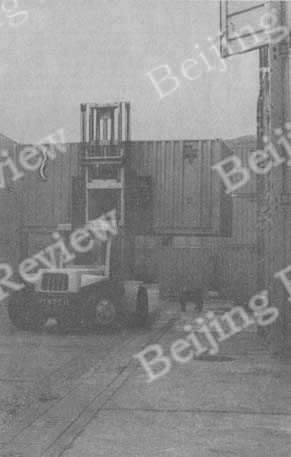
A forklift moves a standard container made by the China International Marine Container Factory.
- A largely market-regulated system of prices will be gradually established, on the condition that prices remain relatively stable.
- Entry and exit procedures and other formalities are simplified for businessmen and visitors.
- The income tax rate for enterprises is set at 15 per cent, which is lower than in Xianggang
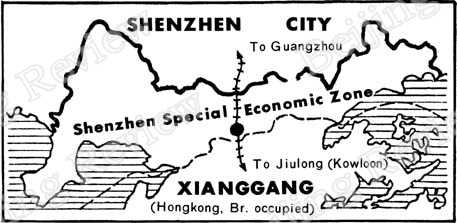
Enterprises with an investment of more than US$5 million or those using high technology and having a relatively long-term capital turnover are granted preferential treatment, with the income tax reduced by 20 to 50 per cent or exempted from one to three years. Foreign and overseas Chinese businessmen who reinvest their profits in the special zones for five years or more may apply for a reduction or exemption of income tax on the amount reinvested.
- Apart from cigarettes and liquor, approved imports for use within the special zones, such as means of production and articles in daily use, are exempt from customs duties.
- Exports also are exempt from customs duties.
- There is plenty of industrial property available for investors at costs much lower than in Xianggang. Different industries can get preferential treatment regarding the choice and use of land sites.
- Special zones produce mainly exports. But a portion of their goods which are needed in domestic markets can be sold in China.
China practises a planned economy. However, Shenzhen's economy, under the guidance of state planning, is basically regulated by markets. In the special zones, a large proportion of the enterprises is made up of joint ventures and individually financed enterprises. (This is also quite different from the rest of China, where a socialist economy prevails.) Both parties in a joint venture own the means of production and have management right; accordingly, they should conduct economic cooperation on the basis of equality and mutual benefit. Individually financed enterprises are a specific kind of capitalism under the control and administration of the Chinese Government. These investors, provided they observe Chinese laws and policies, have the right to manage their own enterprises so that legitimate profits can be made and healthy economic development in the special zones guaranteed.
China's special zones are economic, not political. The word "special" refers to the relaxation of economic policies. The governments of special zones still possess complete sovereignty. When foreign and overseas Chinese businessmen engage in economic activities in the special zones, they must abide by Chinese laws, decrees and regulations. In turn, the Chinese Government must also protect their assets, profits and other legitimate rights and interests according to Chinese law. Thus, the special zones are completely different from the concessions of old China or from "a kingdom within a country."
In other countries, most special zones are limited to a single-product economy with private ownership. The zones in China, however, can receive support from the state and from the rest of the country. Shenzhen, for instance, not only emphasizes the development of heavy industry, but also engages in commerce, agriculture, animal husbandry, housing and tourism. China's special zones provide investors with opportunities for a wide range of businesses.
China is also making efforts to build a high level of civilization and to educate the cadres and masses to conscientiously resist the corrosive influences of bourgeois ideology. This is also the case with the special economic zones which will feature a strict legal system and discipline, good social security and morale, a developed economy, a high level of science and education, and a rich and healthy cultural life. It is incorrect, as some have suggested, to consider the special zones as "enclaves of capitalism."
Achievements and Prospects
Shenzhen has made considerable achievements after three years of construction. Among them are these:
- Laws and regulations. To offer foreigners good investment and management conditions, Shenzhen has drawn up a blueprint for growth called "Outline for the Development of a Socialist Economy in the Shenzhen Special Economic Zone." In addition, since the Regulations Concerning Special Economic Zones in Guangdong Province was promulgated in August 1980, we have formulated more than 10 individual laws and regulations, drawing both from the fundamental spirit of Chinese laws and policies and from the experience-gleaned from international laws and regulations concerning economic activities. Of them, four are in effect: those governing the entry and exit of personnel; industrial and commercial registration; labour and wage administration; and land administration. Five others - those governing the administration of commodities and housing; administration of foreign banks; economic contracts; the import of advanced technology and equipment; and economic arbitration - will come into effect once they are through the legislative process. Regulations concerning companies, privately owned housing, finances and accounting, and trade unions are being drafted.
- Construction. Shenzhen's capital construction is proceeding in a planned way, especially the construction of roads, telecommunications lines, water, gas and electricity supply systems, and drainage in the Luohu and Shangbu districts (covering an area of 24 square kilometres) where extensive ground-levelling is under way. The construction of an 84kilometre administrative perimeter separating the special zone from the rest of the province has been completed.
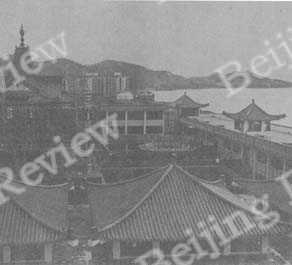
Above: A posh hotel under construction in the eastern part of Zhuhai.
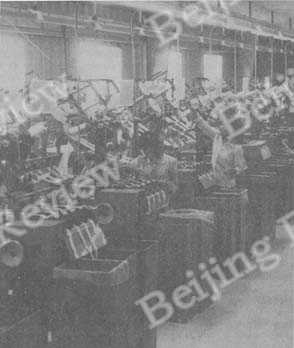
Below: At the newly built Guangfu Synthetic Material Factory in Shenzhen.
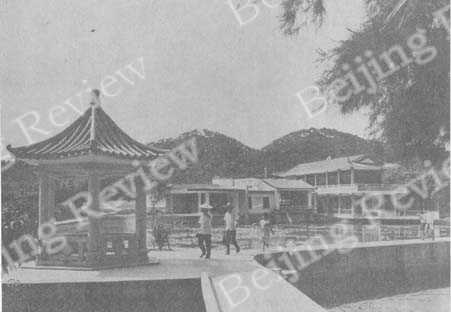
Visitors stroll through the Seashore Park in Zhuhai.
From 1979 to 1983, Shenzhen spent 1,990 million yuan on capital construction, completing 3,250,000 square metres of floor space. A large number of industrial and residential buildings, department stores, modern hotels and restaurants, and picturesque scenic spots with up-to-date facilities were completed. Fifty-five roads are being built or expanded in the city district, of which 37 roads with a total length of 56 kilometres have been completed. The administrative structure has been simplified to reduce personnel, ease formalities, and raise efficiency.
- Equipment and technology from abroad. People from business and other fields have come from Japan, the United States, Britain, the Federal Republic of Germany, Australia, New Zealand, Thailand, Xianggang and elsewhere for inspection, visits and trade talks. By the end of last year, Shenzhen had concluded 2,506 agreements with foreign and overseas Chinese businesses for a total of HK$ 13,220 million, of which 2,740 million dollars have already been put to use. Most of the projects in operation have made encouraging progress in management and administration. Both sides have received economic profits.
Shenzhen has also imported more than 20,000 pieces (sets) of machines and equipment, including microwave telecommunications equipment for the Shekou industrial district; seven-colour printing equipment; an electronically controlled batching plant; the technology and equipment for producing marine paint at the Haihong Paint Factory of Shekou; and a continuous-casting machine for the Huamei Steel Mill. The imported technology and equipment have not only strengthened productive forces in the special zone but also raised the competitiveness of the products in international markets.
- Production. Industrial output value increased by 101 per cent in 1983 from 1979, before the special zones were created; agricultural output value increased 25 per cent, financial revenue 600 per cent, and local income in foreign exchange 140 per cent. The proportion of industry in the zone has expanded rapidly. By the end of last year. 164 new industrial enterprises had been set up in the city, of which 55 were built and put in operation in 1983. The special zone now has industrial enterprises in electronics, textiles, clothing, food, furniture, printing, building materials and machinery.
- People's livelihood. In the past three years, more than 30,000 young people have found jobs in Shenzhen. The average wage of workers and staff in state-owned enterprises rose 129 per cent in 1983 from 1979. The average annual income for peasants rose by 218 per cent.
It is estimated that Shenzhen's population will rise from 250,000 to 400,000 in 1990; the number of factories will rise from 140 to 470, and the number of workers and staff from 30,000 to 80,000. Annual labour productivity will rise to 45,000 yuan per capita from 20,000 yuan in 1982, and total industrial output value will increase to 3,600 million yuan.
Because of the zone's narrow topography and acting on the "principle of being advantageous to production and making life more convenient," the Shenzhen government plans to gradually set up 18 sections of the city based on industrial or residential function, separated by gardens and belts of trees. Of the zone's 327.5 square kilometres, 110 square kilometres are devoted to urban construction, according to the preliminary plan.
Through political and ideological education, cadres and workers in Shenzhen are able to conscientiously resist the corrosive influence of bourgeois ideology. They love socialism and are confident that the special zone will be well run.
After several years of hard work, a modern socialist city with a high level of civilization will rise on the shores of the South China Sea.
